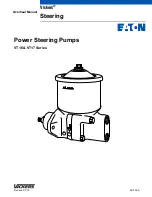
Siemens Industry, Inc.
Building Technologies Division
P/N 315-033060-19
2
•
Two separate power output terminals: one power limited terminal with 4A
max @ 24VDC capacity and one non-power limited terminal with 12A max
@ 24VDC capacity (total not to exceed 12A)
•
Both output terminals have current measurement capability
•
Auto resettable current protection circuits for overload and short circuit
•
Access to CC-5/CC-2 System bus
•
Supplies 6.2VDC @ 2A (power limited) to the system bus
•
Supplies 24VDC @ 2A (power limited) to the system bus (subject to a 12A
total current limit)
•
Communicates via HNET protocol
•
Provides termination for the tamper switch
•
One common alarm relay, one common trouble relay and two program-
mable relays with 2A ratings
OPERATION
The PSC-12 occupies one network address in the HNET network and has four functional
components: the Controller, the Charger, the Power Supply and the Interface Board.
The Controller determines the activation of the Charger and monitors the status of
the Power Supply (ground fault conditions, loss of network communication, 24VDC
terminal overload and the status of the battery). This information is relayed to the
User Interface, where applicable, and is communicated to the PMI/PMI-2/PMI-3
(XLS), FCM2041-U2 (Desigo Fire Safety Modular), FCM2041-U3 (Cerberus PRO
Modular) for system reporting. The Controller also allows the PMI/PMI-2/PMI-3 (XLS),
FCM2041-U2 (Desigo Fire Safety Modular), FCM2041-U3 (Cerberus PRO Modular) to
query the state of the power supply and its current load and can send a diagnostics
command to the PSC-12. It also provides the control of the relays.
The degrade ALARM bus and degrade TROUBLE bus will override the command that
is sent by the PMI/PMI-2/PMI-3 (XLS), FCM2041-U2 (Desigo Fire Safety Modular),
FCM2041-U3 (Cerberus PRO Modular) to the Alarm and Trouble relays.
The Power Supply has an Off-line switch mode power converter and power factor
correction circuit to improve conductive RF emission at low frequency. It is designed
to take voltage inputs of 120VAC-240VAC at 60Hz/50Hz and has one resettable
circuit breaker that can also be used as a battery power switch.
The Charger monitors and maintains the battery. This circuitry utilizes three charge
modes, depending upon the state of the batteries: Bulk (Full) Charge State, Trickle
Charge State and Float (maintenance) State. The Charger monitors the batteries and
determines which of the charging modes to activate. It also has the capability to
check the state of the battery through diagnostic testing.
The Interface Board provides diagnostics LEDs, system connections and the terminal
connections on the PSC-12.
Terminal Blocks,
The PSC-12 has one reset switch, seven LEDs, three HNET/CAN address switches,
one circuit breaker, four terminal blocks, four terminal connections and two 60 pin flat
ribbon connections as shown in Figure 2.
A reset switch is located on the top of the front panel. Pushing the reset switch re-
initializes the PSC-12 operation.
Controls and Indicators






























